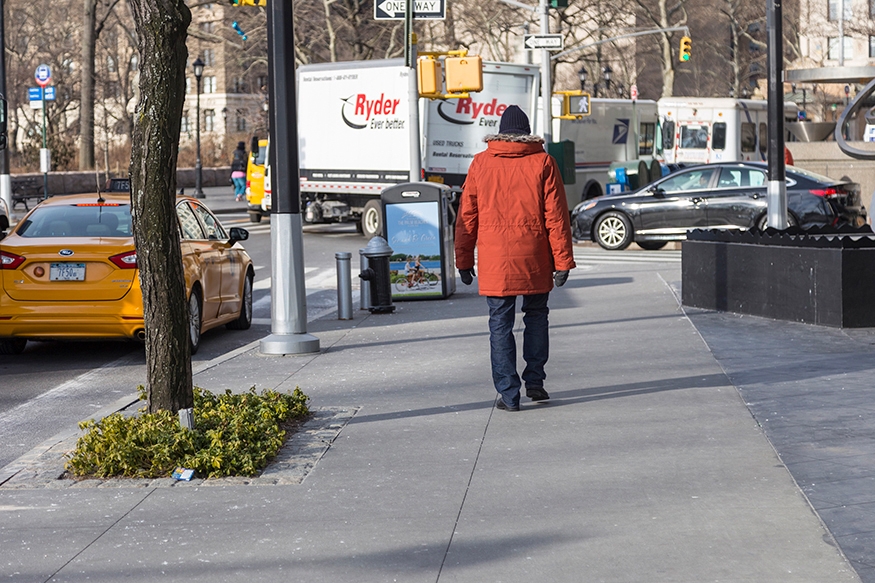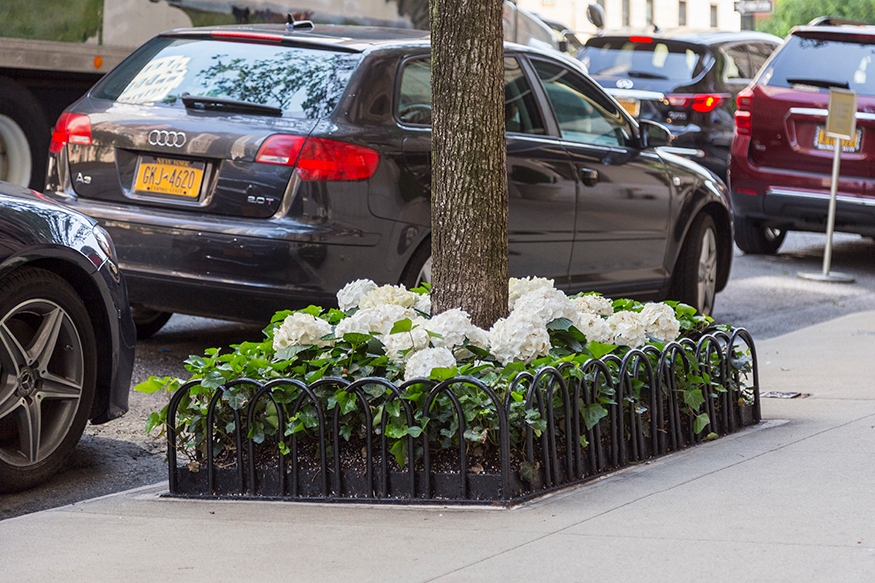Street trees exist within tree beds all over the city. Existing trees should be preserved, and new trees should be installed wherever feasible if conditions allow. Per Local Law 1065 of 2023, NYC has set a target to reach 30% overall tree canopy within the city by 2035.
Tree beds are currently the only required design, however, Connected Tree Beds should be used wherever possible to provide for improved tree health. Planted Stormwater Management Practices, those that take water from the roadway, should be considered wherever feasible and maintenance can be provided.


Benefits
Review Benefits of Plantings in the Right-of-Way (ROW)
- For additional information on the benefits of trees, review the United States Department of Agriculture's NYC Municipal Forest Resource Analysis
Considerations
Review Key Considerations
Review Key Considerations: Tree Preservation & Protection
- Tree beds are standard treatments that Parks installs and maintains. Other entities are also encouraged to pursue this treatment but require permits from Parks and DOT
- DOT and Parks permits are required to install trees. The permit holder must maintain and establish the tree for one year. Trees installed as part of street reconstruction projects must establish the tree for two years per DOT Standard Specifications
-
Parks contractors will maintain tree beds (individual or connected) planted by Parks for one year after planting, after which each individual property owner is responsible for maintaining the tree bed(s), while Parks retains responsibility for and jurisdiction over the tree itself. For more information, review Parks’ webpage on tree bed care.
Application
- The New York City Zoning Resolution requires that one tree be provided for every 25 feet of curb frontage for new developments and major alterations; all other spacing requirements per Parks Tree Planting Standards still apply
- Tree beds should be installed wherever feasible. Consider in context of geometric treatments like Full Sidewalk, Raised Median, Pedestrian Safety Island, Pedestrian Plaza, Shared Street, Open Street, and Bike Boulevard. If visibility is not an issue, also consider Curb Extension, Gateway, Chicane, and Roundabouts
-
Refer to Planting Locations for additional guidance within specific right-of-way contexts
- Use Connected Tree Beds rather than tree beds wherever possible to increase root space and stormwater detention capacity
- Consider Stormwater Management Practices where conditions are appropriate
- Specific constraints may apply if planting near Flood Protection Systems
Design
Review Key Considerations: Spacing & Siting Requirements
Review Key Considerations: Soils
Size and Clearances
- Meet or exceed minimum size and design requirements of Parks Tree Planting Standards contingent upon accommodation of pedestrian capacity and sub-surface constraints
- Tree-bed sizes may vary depending on site conditions and should be designed to be as large as possible; Parks typically requires a 5-feet by 10-feet opening with soil only
- Minimum distance between trees (trunk to trunk) is 20 feet to 30 feet, depending upon the tree species and other local conditions. Generally, smaller trees or groups of trees planted together may be spaced more closely. Trees with larger canopy spread at maturity should be spaced accordingly
- A minimum 8-feet clear path must generally be maintained. DOT may require a lesser or greater clear path on specific corridors based on the Pedestrian Mobility Plan. Exceptions may be approved by DOT and Parks on a case-by-case basis. In all cases, a tree bed should not take up more than 50% of the total sidewalk width or reduce the sidewalk width to less than 4 feet
Supporting Healthy Trees
- Diversify street tree species along a block to avoid species blight and plant the largest-canopy species that site conditions allow, in coordination with Parks
- Maximize exposed soil to allow more water and air to get to the roots of the tree; if necessary due to high pedestrian traffic or constrained sidewalk widths, use Parks-approved permeable surface treatments over the tree bed; consider a suspended pavement system adjacent to the tree bed to extend available rooting area
- Do not remove or add topsoil around the rooting area of established trees; mulch is preferred, but should follow DOT and Parks specifications
Tree Bed Planting and Protection
- Review the Plant Finder for Parks approved trees and other plants that perform well in the right-of-way. All selections must be made based on specific site considerations
- Do not install any plants within the area of the root ball of a new tree or within 3 feet of the trunk of an established tree
- When planting beneath the canopies (within the driplines) of established trees, choose plants in containers no larger than 1 gallon each to minimize damage to trees
- Tree-bed grates that are flush with the sidewalk and vertical tree guards that enclose the tree trunk are not permitted
- Tree guards are recommended where feasible and where maintenance can be provided. One of Parks’ standard tree-bed guards should be used
- Tree beds without tree-bed guards must have a flat surface and be no more than one quarter (1/4) inch above or below the adjacent sidewalk surface